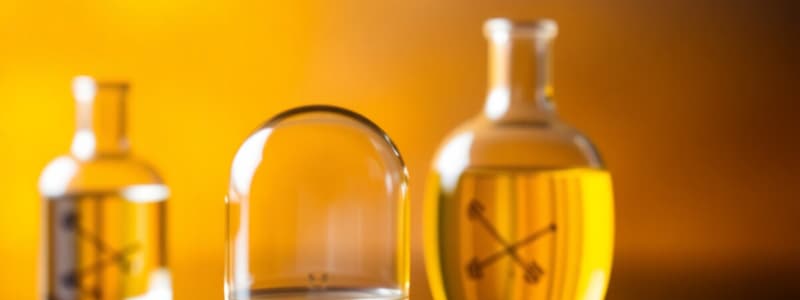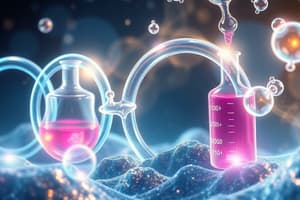Podcast
Questions and Answers
What characterizes constitutional isomers?
What characterizes constitutional isomers?
- They have only one structure representation.
- They are distinct compounds with varying properties. (correct)
- They have the same molecular formula and properties.
- They are always in a straight-chain structure.
Which naming convention is used for alkanes?
Which naming convention is used for alkanes?
- The first four names are based on atomic numbers.
- The suffix '-ane' indicates that the compound is an alkane. (correct)
- Each name is related to the molecular weight of the compound.
- Alkane names are derived from Latin numbers.
What happens when a hydrogen atom is removed from an alkane?
What happens when a hydrogen atom is removed from an alkane?
- It generates an alkyl group. (correct)
- It converts the alkane into a cyclic structure.
- It forms a stable alkane.
- It creates a new functional group.
Which of the following correctly represents butane?
Which of the following correctly represents butane?
What suffix is used to denote alkyl groups derived from alkanes?
What suffix is used to denote alkyl groups derived from alkanes?
What is the general formula for alkanes?
What is the general formula for alkanes?
Which of the following accurately describes isomers?
Which of the following accurately describes isomers?
What are straight-chain alkanes also referred to as?
What are straight-chain alkanes also referred to as?
What is the result of the overlap of carbon sp3 hybrid orbitals in alkanes?
What is the result of the overlap of carbon sp3 hybrid orbitals in alkanes?
Which of the following is an example of a branched-chain alkane?
Which of the following is an example of a branched-chain alkane?
Flashcards are hidden until you start studying
Study Notes
Alkanes
- Alkanes are the simplest family of molecules containing only carbon-carbon single bonds, formed by the overlap of carbon's sp3 hybrid orbitals.
- They are saturated hydrocarbons, meaning they contain only carbon and hydrogen atoms and have the maximum possible number of hydrogen atoms per carbon.
- The general formula for alkanes is CnH2n+2, where n is an integer.
- Alkanes are sometimes called aliphatic compounds.
Methane, Ethane, and Propane
- Methane (CH4) is the simplest alkane with one carbon atom and four hydrogen atoms.
- Ethane (CH3CH3) has two carbon atoms and six hydrogen atoms.
- Propane (CH3CH2CH3) has three carbon atoms and eight hydrogen atoms.
Structural Isomers
- Isomers are compounds with the same number and types of atoms but different arrangements.
- Butane (C4H10) and isobutane (C4H10) are constitutional isomers, having different carbon skeletons.
- The number of possible alkane isomers increases dramatically as the number of carbon atoms increases.
- Constitutional isomerism is common in organic chemistry and can involve different carbon skeletons, functional groups, or locations of functional groups.
Naming Alkanes
- Straight-chain (normal) alkanes are named based on the number of carbon atoms they contain, using Greek numerical prefixes and the suffix "-ane."
- The first four alkanes (methane, ethane, propane, and butane) have historical names.
- Alkane names form the basis for naming other organic compounds, so memorizing the first ten is essential.
Alkyl Groups
- Alkyl groups are formed by removing a hydrogen atom from an alkane.
- They are not stable compounds but rather parts of larger molecules.
- Alkyl groups are named by replacing the "-ane" ending of the parent alkane with "-yl."
Naming Branched Alkanes
- Identify the longest continuous carbon chain as the parent chain.
- Number the carbon atoms in the parent chain starting at the end closest to the first branch point.
- Identify and number each substituent (branch) by its position on the parent chain.
- Write the name as a single word, using hyphens to separate prefixes and commas to separate numbers.
- List substituents alphabetically, using prefixes like "di-", "tri-", or "tetra" for multiple identical substituents.
- Name branched substituents as if they were separate compounds, treating them as a whole and including their numerical prefixes when alphabetizing.
Physical Properties of Alkanes
- Alkanes are nonpolar and therefore insoluble in water (hydrophobic).
- They are good solvents for nonpolar or weakly polar organic substances.
- Alkanes are good lubricants and preservatives for metals, preventing corrosion by keeping water away.
- Alkanes have densities around 0.7 g/mL, making them less dense than water and causing them to float.
- Boiling and melting points of alkanes increase with increasing molecular weight due to the increasing strength of dispersion forces.
- Branched-chain alkanes have lower boiling points than straight-chain alkanes because their spherical shape leads to smaller surface areas and weaker dispersion forces.
Reactions of Alkanes
- Alkanes are relatively unreactive and are sometimes called "paraffins" (meaning "little affinity").
- They are primarily used as fuels, solvents, and lubricants.
- Alkanes undergo combustion with oxygen to produce carbon dioxide, water, and heat.
- Cracking and hydrocracking processes break down large alkanes into smaller ones, often to produce gasoline.
- Halogenation reactions involve the replacement of hydrogen atoms in alkanes with halogen atoms (F, Cl, Br, I), typically using ultraviolet light.
- Halogenation reactions yield a mixture of products with varying degrees of halogen substitution.
Combustion
- Combustion is a rapid oxidation reaction happening at high temperatures, converting alkanes to carbon dioxide and water.
- This process releases significant heat and is used for fuel sources.
Cracking and Hydrocracking
- Large hydrocarbons are broken down into smaller ones by cracking, typically performed at high temperatures to maximize gasoline production.
- Hydrocracking involves adding hydrogen to the cracking process, resulting in saturated hydrocarbons. Cracking without hydrogen yields a mixture of alkanes and alkenes.
Halogenation
- Alkanes react with halogens (F2, Cl2, Br2, I2) to form alkyl halides.
- Methane reacts with chlorine to form chloromethane, dichloromethane, trichloromethane, and tetrachloromethane.
- Halogenation typically involves ultraviolet light irradiation and leads to a mixture of chlorinated products with varying degrees of substitution.
Studying That Suits You
Use AI to generate personalized quizzes and flashcards to suit your learning preferences.




